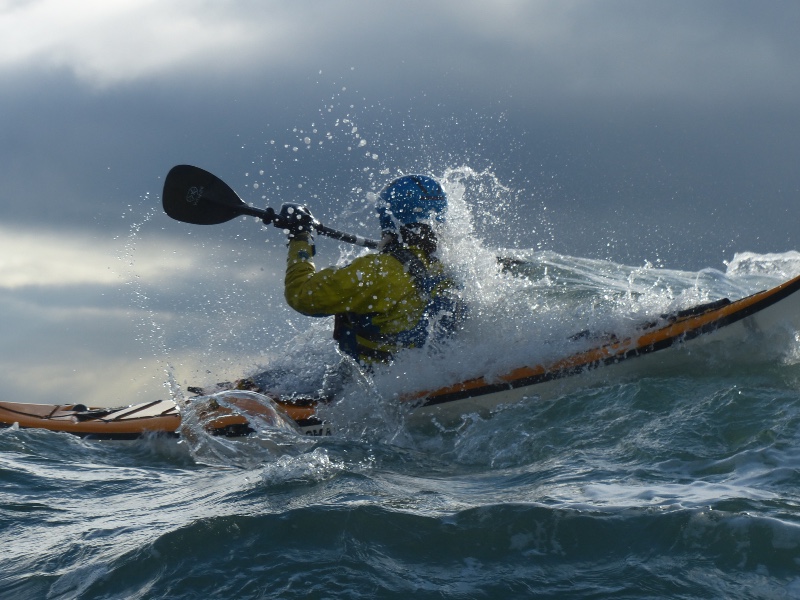Photo by Sea Kayaking Anglesey
Holy Island, off Anglesey, North Wales, has some of the world’s best tidal races. This is due to its prominent position in the Irish Sea, its tidal range, it rocky geology and its exposure to the prevailing wind and waves.
This article looks at how, where and when to play in the races off the island. However, it does not cover all the safety aspects involved with tidal races. As well as being great fun, tidal races can be very dangerous, so if you are at all unsure of your own abilities or the conditions on the water leave it for another day or get experienced assistance.
All tide times are in relation to Holyhead. The information is opinion and not necessarily accurate. Some of the information differs to that of other sources. Don’t rely solely on this article, check the local charts, tide stream atlases, cruising guides and pilots.
Penrhyn Mawr
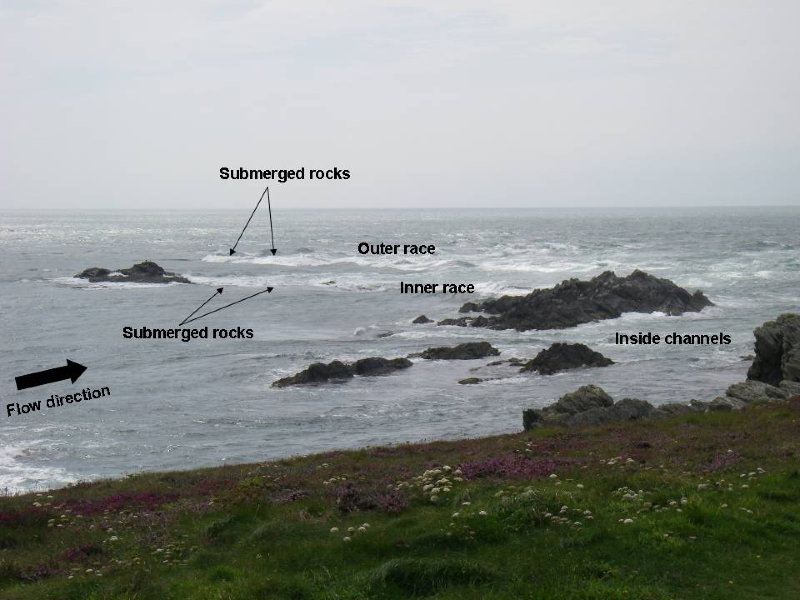
Photo by Sea Kayaking Anglesey
Marked as as Penrhos Point on charts. Works on the flood, not on the ebb. Seven knots at springs, four knots at neaps.
Due to a back eddy that forms in Penrhos Bay during the ebb, the flood flow starts 2 hours before low water Holyhead on springs, 1 hour before on neaps, and runs till high water. The peak flow is before mid tide. The flood flow direction is from the south-east to the north-west. It is exposed to waves from the south and west. Gul Rock, off the headland, one kilometre east, works like a mini Penrhyn Mawr. If it is big enough for you here the main race will be too big.
InsIde channels: These provide an easier route up against the flow and a more sheltered flow to practise or warm up in. Rescues in here can be hampered by the flow pushing on to rocks down stream.
Inner race: This forms a smaller, more manageable race than the outer race. However it is just as fast and the eddy lines are quite a challenge.
Outer race: Being more exposed, this tends to form a larger waves. Watch out for ‘The Fangs’, two rocks 100m SSW of the outermost fully exposed rock, which cover at mid tide.
EddIes: There are several small eddies in the inside channels with bigger ones on either side. There is a big eddy between there and the Inner race and another between the Inner and the Outer. There is also an eddy behind ‘The Fangs’.
South Stack
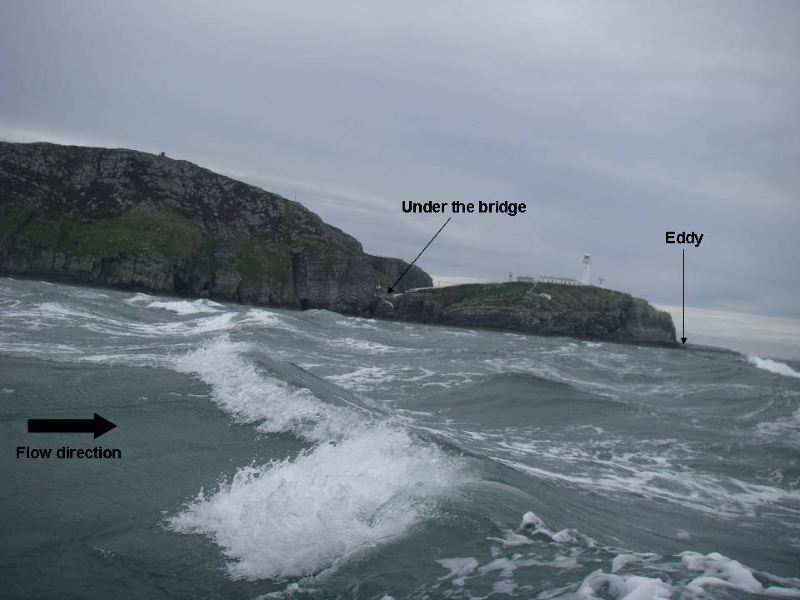
Photo by Sea Kayaking Anglesey
Works on both the flood and the ebb. Six knots at springs, three knots at neaps. Under the bridge the tides changes ten minutes before Holyhead, but in the Outer race they change half an hour before both ways. In the Outer race the flood flow direction is south to north; and on the ebb, north to south. It is exposed from the south, west and north.
Under the bridge: This can provide an easier or at least shorter route up against the tide, but doesn’t offer much play potential as it is in a confined space. Rescues are serious due to the risk of the boat getting stuck across the gap.
Around the Island: This sometimes forms surfable waves but can reliably provide fast-flowing bumpy water.
Outer race: This only forms when the conditions are right, generally around mid tide of a bigger tide, and with some wind or more importantly longer period swell against it. Because of the prevailing conditions it more commonly forms on the ebb and more rarely on the flood. The race forms over the ten fathom (20 metre) underwater spur running out west from South Stack. The surfable waves start a few hundred meters out from South Stack and stretch out to sea in a wide race that is only a few surfable waves deep. The smallest waves are closer to land and they get bigger the further out you go. On the ebb as soon as you drop off the front few waves, start to ferry glide in behind South Stack as if you miss the eddy here it is a long paddle. This race is a dangerous place to have anything go wrong as there are no eddies and the flow pushes you out to sea, particularly on the ebb. In certain conditions it can form heavy dumping waves and it can be difficult to tell how big they are until you are very close. When working well it forms the best sea kayak surfing waves on Anglesey.
Eddies: On the flood there is a huge eddy in Gogarth bay. On the ebb there is an eddy on the South-West side of South Stack. There are no eddies where the tide race forms.
North Stack
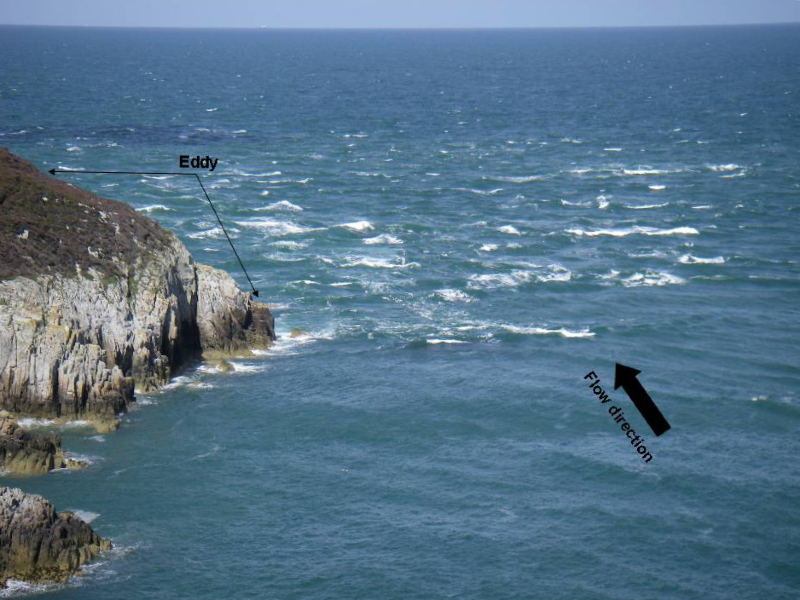
Photo by Sea Kayaking Anglesey
Works on the ebb, not the flood. Seven knots at springs, four knots at neaps. Due to a back eddy that forms in Holyhead Bay during the flood, the ebb flow starts two hours early on springs and one hour early on neaps. The ebb flow direction is east to west. It is exposed from the north and west. If you are dropping down to it from upstream, keep close to the cliffs well before you get to it, enabling you to stop and look at it. The high-speed ferries cause a double wake that can wipe out all but the deepest parts of the eddies a few minutes after passing. The top of the race is formed by very shallow rocks which tend to be most surfable early on. Later on, the better waves tend to be further back in the race but only if there are conditions to generate them.
Eddies: There is an eddy running alongside the cliff all the way to but not beyond the very top of the race.
Rhoscolyn
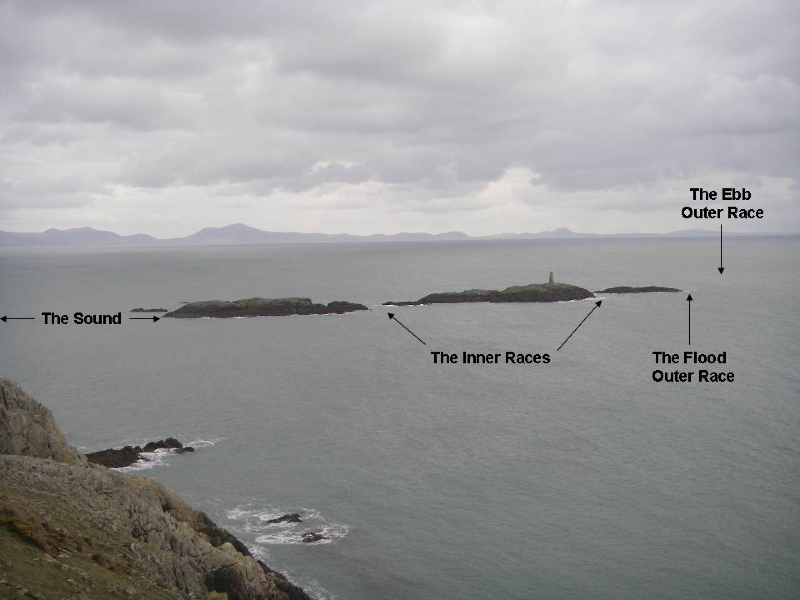
Photo by Sea Kayaking Anglesey
This race is a little slower and tends to form smaller waves than the other three. Although the tide flows all around Rhoscolyn Head, the most consistent surfable waves form in the races off the Beacon Rocks, which is where this guide looks at. This area works on both the flood and the ebb. 2 knots at neaps, 4 knots midway between the springs and neaps and 2 knots at springs. This is not a typo, the flow slows down as it approaches springs, presumably because the main flow stays further off shore.
Both the flood and the ebb start and finish about 45 minutes before low and high water Holyhead. The flood flow direction is to the north-west and the ebb to the south-east. It is exposed from the South, West and East. The flood flow is stronger, the ebb flows against the prevailing conditions.
The sound: This wide area of flow is relatively sheltered, forming smaller waves. The flow tends to be fastest close to the beacon rocks.
Inner races: These flows are narrower than the sound and more sheltered so tend to be smaller, but they are shallow so swell can have a more pronounced effect.
Outer race: This is the most exposed area. With the right wind and wave conditions it forms surfable waves close into the rocks on the flood and in a spot 100 meters out south-westerly on the ebb. On the ebb, with the wind against you it can be a hard paddle back in.
eddIes: There are eddies behind every rock.
Safely in tide races
Having the judgement to know if it is safe or not to go into a tide race is vital and this article cannot cover all the safety aspects of paddling in races. Here are a few key points:
All the races mentioned above can be viewed from the land. To help you get to know them have a look at them in a variety of conditions.
Check the tide times; wind strength and direction; and swell size, period and direction.
You can arrive at a race early before it gets too big, or wait till it slows down and is smaller.
If you are dropping down with the flow to a tide race, stop safely above it to make sure it is okay before you drop into it.
Be aware once the flow gets too fast you won’t be able to paddle up against it till it slows down again.
If the swell makes the eddies unusable, the race is unusable, as the eddies are where you recover incidents too.
Don’t put yourself in a position where you have to paddle into a tidal race.
You or someone in your group needs to be able to recover yourself and all the other members of the group from any foreseeable situation.
Suggested reading:
- Sea kayaking safely: An interview with Nigel Dennis
- What’s best for base layers: Synthetic or natural?
- Calling for help: Devices for sea kayakers

By Philip Clegg
With two decades of working in the sea kayaking industry, Phil can be found on a daily basis coaching and paddling on the coastline of Anglesey. That’s when he’s not travelling the world expeditioning, coaching and testing kit.

